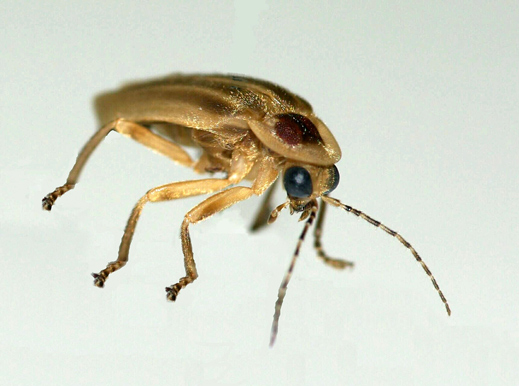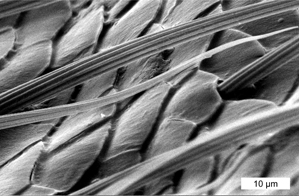Fireflies Inspire Brighter LEDs
By mimicking the jagged structure of a lightning bug’s “lantern” in a layer on top of existing LEDs, or light-emitting diodes, a team of researchers in Belgium, France, and Canada increased the amount of light from the semiconductor device by up to 55 percent.

Much of the light produced by LEDs gets reflected back into the device due to large differences between how light travels through the LED materials compared to air. This reduces “drastically the efficiency of LEDs,” says Annick Bay, a doctoral student at the University of Namur in Belgium and first author on the studies. The bioluminescent light produced by a firefly faces a similar challenge when traveling out of the insect’s abdomen.

The authors examined the microscopic structure of the abdomen of a firefly found in Panama and discovered that the insect’s exoskeleton in this region of the body had jagged, misfit scales. Computer simulations and bench experiments confirmed that the sharp edges of these scales let out more light, the team reported in Optics Express.
In a second report, also in Optics Express, Bay and colleagues at the University of Sherbrooke in Canada describe how a layer of similarly jagged material that they added to a standard gallium-nitride LED increased the amount of light that shone from the device by up to 55 percent. Adding such a feature to existing LEDs could save energy, says Bay, because the craggy coating makes LEDs glow brighter.
A group of Korean researchers reported recently that nanostructures in the exoskeleton of another species of firefly act as an anti-reflective layer, which helps more light shine out of the insect’s lantern. The team built LEDs with unique lenses inspired by these nanostructures that transmitted 3 percent more light.
Unlike the nanostructure-inspired modifications, however, the jagged-scale modification can be made post-production on conventional LEDs. “One advantage of [our] technique is that it can be coated on nearly every commercially available LED,” says Bay.
Keep Reading
Most Popular
Large language models can do jaw-dropping things. But nobody knows exactly why.
And that's a problem. Figuring it out is one of the biggest scientific puzzles of our time and a crucial step towards controlling more powerful future models.
How scientists traced a mysterious covid case back to six toilets
When wastewater surveillance turns into a hunt for a single infected individual, the ethics get tricky.
The problem with plug-in hybrids? Their drivers.
Plug-in hybrids are often sold as a transition to EVs, but new data from Europe shows we’re still underestimating the emissions they produce.
Stay connected
Get the latest updates from
MIT Technology Review
Discover special offers, top stories, upcoming events, and more.